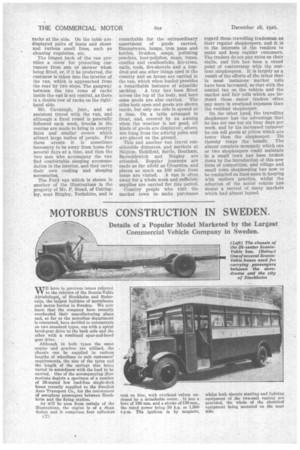MOTORBUS CONSTRUCTION IN SWEDEN.
Page 46

Page 47

If you've noticed an error in this article please click here to report it so we can fix it.
Details of a Popular Model Marketed by the Largest Commercial Vehicle Company in Sweden.
WE have in previous issues referred to the vehicles of the Scania-Vabis Aktiebolaget, of Stockholm and Sodertalje, the largest builders of motorbuses and motor lorries in Sweden. We now learn that the company have recently overhauled their manufacturing plans and, so far as the motorbus department is concerned, have decided to concentrate on two standard types, one with a spiral bevel-gear drive to the back axle and the other with a combined spur-and-bevel gear drive.
Although in both types the same engine and gearbox are utilized, the chassis can be supplied in various lengths of wheelbase to suit customers' requirements, the size of the tyres and the length of the springs also being varied in accordance with the load to be carried. One of the accompanying illustrations depicts a specimen of a number of 26-seated low load-line single-clack buses recently supplied to the Swedish Aero Transport Co., for the conveyance of aeroplane passengers between Stockholm and the flying station. As will be seen from certain of the illustrations, the engine is of a clean design and it comprises four cylinders
cast en bloc, with overhead valves enclosed by a detachable cover. it has a bore of 100 mm. and a stroke of 136 mm., the rated power being 50 h.p. at 1,600 r.p.m. The ignition is by magneto,
whilst both electric starting and lighting equipment of the two-unit variety are provided, the whole of the electrical equipment being mounted on the near side. The engine, disc clutch and four-speed gearbox, with centrally placed control lever, form a unit.
The propeller shaft is built up in two port'ons joined by an enclosed universal joint, the casing of which is supported from one of the cross-members of the frame. An interesting feature of the joint is that provision for its lubri;-ettion is made on the dashboard. As the P11)0 passes close by the silencer the oil is kept sufficiently fluid to flow readily, even in the coldest weather experienced in Sweden.
A liarrly flexible coupling is provided at the rear of the gearbox, whilst the reitr portion of the propellor shaft is enelosed in a easing, the latter having two steadying rods extending from the
extre,aities of the rear axle. A sectional view of the rear axle is reproduced, from which it will be seen that the final drive is by a combination of spiral bevel and spur gearing.
The springs are of the semi-elliptic Pattern, the rear pair being o a progressive type. Their ends are not secured to shackle bolts in the usual way, but arranged to slide in boxes secured to the frame member, the boxes being Provided with wick-feed oil con
tainers and leather gaiters. A centrally located lever actuates internalexpanding brakes on the rear wheels.
The foot-onerated brake works inside a wide drum fitted with cooling flanges at the rear of the gearbox, a simple hand-wheel adjustment being provided at the near side of the latter. Steering is by worm and sector and the steering pivots are set at au angle. The petrol tank, which has a capacity of 22 gallons, is conveniently mounted on the off side of the chassis.
The chassis, which weighs 41 cwt., has a wheelbase of 16 ft. and a track of 5 ft. 2 ins. The length of the frame behind the centre of the rear axle is 5 ft. 3 ins. and the overall length of the bus 23 ft. 5 ins. In order to secure a low-loading platform the chassis frame members are downswept between the front and rear 'axles. The ton of the frame, when the bus is fully loaded, is 263 ins, from the ground. The road wheels are of the steel-disc type, with detachable rims and 324n. by 36-in. pneumatic tyres, twins being fitted at the rear.




































































































